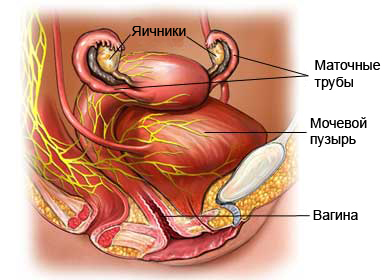Neurogenic bladder is a child
Description of neurogenic bladder in a child
Neurogenic bladder – bladder dysfunction caused by nerve problems. The bladder may empty too often or at the wrong time. This is called incontinence. In other cases, the bladder may be unable to completely empty. This is called urinary retention. Urine can flow from full bladder.

Causes of neurogenic bladder in a child
This disorder is caused by problems with the nerves, extending between the bladder and the brain. In children, neurogenic bladder may be associated with a birth defect of the spinal cord, such as spina bifida. Also, it can cause a disorder:
- Spinal Cord Injury;
- Tumors of the brain or spinal cord in the pelvic area;
- Infection of the brain or spinal cord.
Risk factors for neurogenic bladder in a child
Risk factors include:
- The presence of a birth defect, which affects the spinal cord;
- Certain conditions (eg, early, swelling or infection), that affect the spinal cord.
Symptoms of neurogenic bladder in a child
Symptoms may include:
- A small amount of urine;
- Frequent urination;
- A weak flow of urine;
- The inability to feel, that the bladder is full;
- Tension during urination;
- Inability to urinate;
- Leakage of urine from the bladder;
- Urodynia;
- Urinary tract infections;
- Damage to the kidneys in urine;
- Stones in the kidneys.
These symptoms may be caused by other disorders. If your child has any of these symptoms, consult a doctor.
Diagnosis of neurogenic bladder in a child
The doctor will ask about your symptoms and medical history of the child, and perform a physical examination. He may ask to keep a diary, where you want to celebrate, how often the child to urinate. If the doctor says, that the symptoms may be caused by nerve problems, your child may need tests, such as:
- Analysis of urine – to look for signs of infection or kidney problems;
- Blood tests – to look for evidence of kidney problems;
- Bladder function tests – to evaluate, how well the muscles of the bladder respond to filling and emptying it.
Sometimes it can be assigned to Medical Imaging Tests, eg:
- Roentgen – examination, which uses X-rays, to take a picture of inside the body;
- US – test, which uses sound waves to study the renal, ureter and / or bladder;
- CT scan – It uses x-rays and computer, to make detailed images of the kidneys, ureter and / or bladder;
- Magnetic resonance imaging – the use of powerful magnets and radio waves to take pictures of the brain and / or spinal cord.
Treatment of neurogenic bladder in a child
Treatment options include the following:
Medication
Your doctor may recommend, the child took antibiotics to prevent urinary tract infections.
Catheter
It can be inserted into a thin tube, called a catheter, to release the child from the bladder of urine. You can be trained to perform the procedure themselves, or it can be carried out by a qualified technician.
Operation
If other treatments have been unsuccessful, the operation can be carried out. For Example, Surgery may be needed for increase bladder or to create an artificial sphincter.
Prevention of neurogenic bladder in a child
In most cases, the appearance of neurogenic bladder cannot be avoided. You can help your child avoid spinal cord injuries, taking certain precautions, Putting it like a seat belt in the car.
